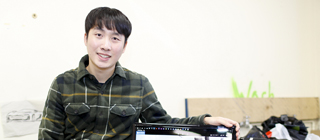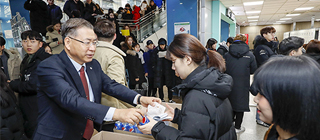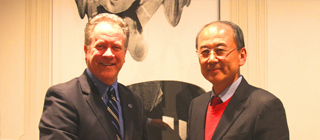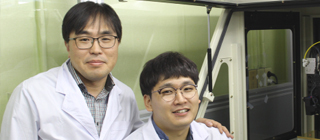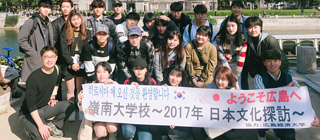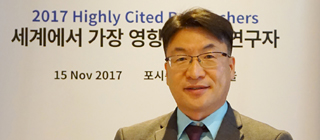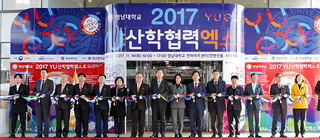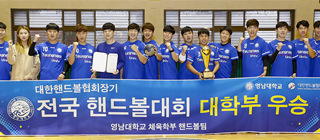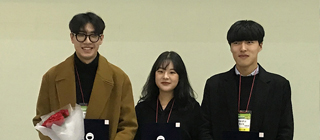-
YU Department of Industrial Design Lee Gi-taek introduced with Korean surrealism photo [December 11, 2017] <Department of Industrial Design Junior Lee Gi-taek who works as a surrealism artist> A man brushes his teeth in the bathroom. Another ego of this man appears in the mirror and pours mouth wash for him. The artwork, ‘Bathroom’ (photo below) was created by Lee Gi-taek (24), a junior at the YU Department of Industrial Design. Mr. Lee took the photo and edited it to express ‘another me helping me after a long day’. This piece will be published as a Korean surrealism artwork in a high school art textbook next year by Jihaksa Publishing Company. This is stirring up big news as there are very few cases in which a student’s artwork was carried by a textbook. Mr. Lee is already famous on social media platforms as a surrealism artist. He took on a different path from his major that mainly designs products. He said, “Three years ago, I decided to draw while serving in the military for self-development and so I began drawing with colored pencils whenever I had time. At the time, I usually drew hyper-realism pieces to look like photographs and I drew pictures in magazines or scenery from the military. But I thought that it was pointless to draw something exactly the way it looked so I decided to add my thoughts in it. I began adding elements that could not exist in reality." He uploaded his drawings on his social media account whenever he was on leave. It was for fun, but visitors to his account called his works surrealism. He would draw shoes as if it were real and express the laces with fingers, or combined hands and a necktie on top of a dog’s head as part of his unique artwork, and visitors to his page gradually began to grow. Lee’s social media account became more popular as both the general public and other artists began to visit his site. He studied about surrealism on his own and one day learned about the artwork of the Swedish surrealism artist Erik Johansson, and from then on, he decided to express surrealism no longer from drawings, but with photos. <Bathroom (Digital camera photo / Variable size / Lee Gi-taek, 2015> After being discharged from the military, he began to take photos of everyday life and use Photoshop to create unique works and continued to upload them on social media account. The number of visitors continued to grow and he now has over 17,000 followers. Lee’s work caught the attention of a textbook publisher who saw his work and the publisher contacted Lee through his social media account and after a year of review, it was confirmed to carry his work in the textbook. Though it started just as a hobby, he continuously uploaded his work and after a while, his social media followers gave him the title ‘artist’. Thanks to this, the Korean Artists Welfare Foundation officially recognized him as an artist in February of last year, and he is now active as an official artist. He also holds various exhibits. Seoul COEX suggested that he hold an exhibit and so he held an exhibit once last year and once this year. Last year, he took a leave-of-absence from school to concentrate on artwork and he leased a small studio in Seoul and has been holding art exhibits in Shinchon and other areas. He returned to school this year and is currently working on his school as well as his artwork simultaneously. “When people ask me about surrealism, I say that it is child-like imagination. I show them my works and tell them let their imagination carry them away. Many professional artists say that my works are ‘B-grade sentiments’, but my ideas are interesting. My classmates used to tease me saying that I was an ‘attention monger’, but now they say that they want to be a part of my works and respect my works.” He hopes to become a professional artist after graduating. Lee said, “I currently work mainly with photographs, but I plan to produce videos and integrate design,” and added, “I want my works to be shared not only in Korea, but abroad as well.”
-
YU President Sur Gil-soo delivers ‘A+ Snacks’ on the morning of the first final exams for the second semester Worked with the Student Government to share hand-made hamburgers and beverages to encourage students [December 12, 2017] <YU President Sur Gil-soo, professors and students of the student government share snacks on the morning of the first day of the finals.> At 8 a.m. on the 12th, the first day of the 2017 second semester finals, students lined up at the library early in the morning to go to the 1st floor lobby of the YU Central Library. YU President Sur Gil-soo, professors and the student government teamed up to deliver morning snacks for students who skipped breakfast to come to school early and study for their tests. <Student government president Park Sung-min (right) shares snacks with students.> Wie Gyu-ho (19, Department of Mathematics Education, Freshman), who lined up early in the morning and was the first to receive the snack, said, “I saw an announcement on the student government Facebook page that said they would give free snacks this morning, so I got in line early.” He added, “I received a snack from the president of the university on the first day of the examinations so I think that I will have good luck in the tests.” Kang In-wook (19, Department of Mathematics Education, Freshman) said, “I stayed up all night at the library to study for my exams. I hope that many students get their free snack and do well on the finals.” The snack delivery was made simultaneously at the YU Central Library basement lobby and Science Library first floor. Hand-made burgers and beverages were prepared for a total of 800 people, but it was so popular that all of them were handed out in just 10 minutes. YU President Sur Gil-soo said, “I am proud of the students who skipped breakfast to come to school early despite the cold weather to study for their tests. I want the students to know that the professors including myself, and other school colleagues are supporting you.” He further added, “I hope you all do well at the finals and end 2017 on a high note.”
-
YU students to participate in WFP internship… ‘Fostering international organization experts’ Department of Saemaul and International Development Professor Choi Wae-chul meets with WFP Secretary-General David Beasely for discussions [November 24, 2017] <YU decided to work together with the UN WFP to lead the eradication of global poverty and hunger by fostering experts.> (Department of Saemaul and International Development Professor Choi Wae-chul (right) and WFP Secretary-General David Beasley) YU agreed to work with the UN WFP (United Nations World Food Programme (hereinafter ‘WFP’) to take the initiative for eradicating global poverty and hunger. By sharing Korea’s development experience and know-how with the WFP and having YU students participate in the WFP internship program, the two institutes agreed to foster international organization experts. In order to discuss details, YU Department of Saemaul and International Development Professor Choi Wae-chul met with WFP Secretary-General David Beasely at the global hunger-eradication event, ‘Towards Zero Hunger’ hosted by the WFP on November 22. Mr. Beasely showed interest on the remarkable growth of Korea achieved in a short period of time and asked many questions as soon as he met with Professor Choi. When asked how Korea was able to overcome poverty in such a short period of time, Professor Choi said, “At the time, Korea pursued reforms in thinking, environmental reforms, and plans to increase income simultaneously.” Mr. Choi further explained about the trust between the public and leaders, consensus and participation of the people, consistent policies, sharing success and failure cases, dedication of leaders, and fostering of human resources. Mr. Beasely also asked to introduce the methods that were actually put into place to prevent corruption, which Mr. Choi answered with the method of delivering support materials to community members during the Saemaul Undong, which Mr. Beasely showed great interest in. Professor Choi also stated, “I am very thankful for the support that the WFP gave for Korea to overcome its state of absolute poverty since 1964. Our university is also making various efforts to repay the help received from the WFP and the international community in the past. I am certain that the Saemaul International Development human resources being fostered by YU will contribute to achieving the ‘zero hunger’ goal set by the international community.” He added, “There are currently YU graduates working at WFP offices in emerging nations. Please allow more YU students to gain practical experience at the WFP through the internship.” Mr. Beasely responded, “I fully agree to the internship proposal” and added, “It is now time for Korea, as an ODA contributor, to provide assertive support for emerging nations facing difficulties to due poverty.” WFP was founded in 1961 and is a UN institute that is leading the eradication of poverty and hunger in over 80 nations as of current. ‘Zero Hunger’ being pursued by the WFP is part of the efforts to make a world without hunger, which is the second sustainable development goal by 2030 being pursued by the international community. WFP is working with Korea’s Ministry of Foreign Affairs and KOICA on the Zero Hunger Community project by adopting the Saemaul Undong model in four nations including Rwanda and Nepal since 2011. Meanwhile, the WFP funded 104,463,511 USD for the overcoming of poverty in Korea for 20 years from 1964 to 1984. There were 23 projects pursued in Korea including food, flood control and day care centers, and the WFP project pursued in Korea was assessed to be a successful case by the international community. WFP signed an agreement with the Korean government in February 2015 to engage in projects to overcome poverty and improve the quality of life in over 30 nations every year.
-
Royal family of Thailand recognizes contributions to the development of forestry in the ASEAN region Served as director of the Korea Forest Service and chairman of the International Union of Forest Research Organizations and played a huge role as an international scholar on forestry Fostering students by teaching international students from emerging nations as a chair professor at the Park Chung Hee School of Policy and Saemaul [November 30, 2017] <Park Chung Hee School of Policy and Saemaul Chair Professor Lee Don-gu received an honorary doctorate’s degree at the Kasetsart University of Thailand for his contributions to the development of the forestry industry.> (From left to right: Chair Professor Lee Don-gu, Kasetsart University President Chongrak Wachrinrat) YU Park Chung Hee School of Policy and Saemaul Chair Professor Lee Don-gu (71, former director of the Korea Forest Service) received an honorary doctorate’s degree from Kasetsart University in Thailand for his contributions to the development of the forestry industry on the 25th of last month. Kasetsart University, which is a prestigious national university of Thailand, was established in 1943 and has seven campuses including one in Bangkok with over 45,000 students enrolled, being one of the biggest universities of Thailand. Chair Professor Lee Don-gu led education/research training for 12 years (2000-2011) as the project supervisor of Kasetsart University in the Korea-ACEAN environment cooperation project (AKECOP) and was recognized for his contributions to the development of forestry in the ASEAN region. Korea has been fostering ASEAN regional experts through AKECOP from 2000. <Princess of Thailand Chulabhorn Walailak gives YU Park Chung Hee School of Policy and Saemaul Chair Professor Lee Don-gu an honorary doctorate’s degree.> Chair Professor Lee Don-gu served as the director of the Korea Forest Service, chairman of the International Union of Forest Research Organizations, and chair of the UN Convention to Combat Desertification (UNCDD), playing a big role as an international scholar on forestry. Professor Lee is judged to have contributed greatly in the development and dissemination of domestic forest sciences through his abundant research experience and international relations. Professor Lee majored in forest sciences at Seoul National University and focused only on forestry for over 40 years. He is currently serving as a chair professor at the YU Park Chung Hee School of Policy and Saemaul to pass on the success experiences and knowledge of Korea’s forestry and greenification to international students from emerging countries through lectures on afforestation and forest ecologies.
-
Use of printing technologies, low cost and very easy... Crystal-type electronic materials real-time directing printing technology Can be applied in flexible electronic devices such as smart displays and biosensors Published in world-acclaimed academic journal in the physics and chemistry sector [December 1, 2017] <YU School of Chemical Engineering Professor Kim Se-hyun (left) and Bae Jae-hyun who developed the crystal-type electronic materials direct printing technology applying flexible electronic devices> YU School of Chemical Engineering Professor Kim Se-hyun’s research team (major in polymers and bio materials) developed the crystal-type electronic materials direct printing technology that can be applied to flexible electronic devices. Crystallization and pattern-forming technologies for electronic materials in the past had multiple and complex procedures. The real-time direct printing technology that Professor Kim’s research team developed is a very simple technology that can control the crystallization orientation and patterns of electronic materials at low costs. . <Crystal-type electronic device printing technology developed by Professor Kim’s research team in action> The printing technology of ink-jet printers commonly used today discharge ink through external pressure. Compared to this, the technology developed by Professor Kim’s research team applies an electric field between the nozzle and substrate to improve the crystal orientation of electronic material molecules, while forming patterns through the movement of the nozzle. <Crystallization orientation and patterns of electronic material molecules produced with the crystal-type electronic materials direct printing technology> Professor Kim who led this research explained, “Because the crystallization direction and formation process are determined through the electric field and nozzle direction, very simple and large-area crystallization control is possible.” He added, “The technology developed here is expected to be applied in various flexible electronic devices. In addition to the transistor shown in this study, the technology was applied in smart window displays for which colors change depending on the electric field, and bio sensors as well, and we are planning to expand the fields of application through follow-up research.” The research results were published in the latest issue of the world-acclaimed academic journal in physical chemistry, <Journal of Physical Chemistry Letters> (impact factor (IF) 9.353). This research was joined by Bae Jae-hyun (YU Graduate School of Advanced Organic Materials Engineering master’s degree graduate, current senior researcher at LG Display) as the first author and Professor Kim Se-hyun as the corresponding author.
-
Tracking the traces of the Joseon Tongshinsa (Korean delegation) in Hiroshima and engaging in peace activities Japanese press coverage Pursuing programs for understanding the history and culture of Korea and Japan, presenting Korea-Japan exchange model [November 22, 2017] <YU Department of Japanese Language & Literature students visited Hiroshima as the ‘21st Century Joseon Tongshinsa’. (Hiroshima Peace Park Nuclear Blast Dome)> YU students visited Japan and acted as the ‘21st Century Joseon Tongshinsa (Korean delegation)’. Twenty students in the YU Department of Japanese Language & Literature visited Hiroshima, Japan from November 5 to 11 and made field trips and took part in exchange activities based on the theme of ‘Joseon Tongshinsa and Peace’ together with students from the Hiroshima University of Economics, which is a sister university. During this program, students from the two universities were invited to the ‘Congratulatory Banquet for the Registration of the Joseon Tongshinsa Records as a UNESCO World Cultural Heritage’ and pledged to act as bridges for the peace between Korea and Japan as the ‘21st Century Joseon Tongshinsa’. On the eve of the event, the students visited the Tomonoura region of Hiroshima Prefecture, which was said to be always visited by the Joseon delegation in the past, to examine the records and traces left by the delegates. In addition, as this year marks the 20th year since Daegu and Hiroshima becoming sister cities, the students of the two universities discussed the topic of ‘Thinking of Korea-Japan Peace in Daegu and Hiroshima’ to rekindle the meaning of peace. Such activities of the YU Department of Japanese Language & Literature received attention from the Japanese press as well. The biggest local press company of Hiroshima, ‘Chukoku Newspaper’ introduced the activities of YU students on its November 11 issue (article and photo on right). The YU Department of Japanese Language & Literature has been offering local learning activities for students through annual Japanese culture visit programs as well as Korea-Japan exchange activities by visiting Hiroshima, the sister city of Daegu from 2015. In November of last year, students visited Hiroshima and met with Former Hiroshima Mayor Hiraoka Takashi and those who experienced the nuclear bomb in Hiroshima in 1945 to share the true face of war and historical incidents to learn about the meaning of peace. Also, the ‘Korea-Japan joint exploration project’ was pursued together with students of the Hiroshima University of Economics as students traveled back and forth Korea and Japan in August to track the traces of the Joseon Tongshinsa and explore the modern history and culture of Korea and Japan. Recently, they participated in the planning of events related to the Joseon Tongshinsa hosted by Yeongcheon City, which was a base point for the Joseon Tongshinsa, as they worked as 21st Century Joseon Tongshinsa in both Korea and Japan. YU Department of Japanese Language & Literature Professor Choi Beom-soon said, “In this meaningful year celebrating the 20th year anniversary of sisterhood relations between Daegu and Hiroshima, students of the two countries discussed the meaning of peace and engaged in exchange activities to be able to understand each other’s history and culture.” He added, “Daegu and Hiroshima have a lot of history and culture that can be shared such as the history of the Joseon Tongshinsa and the issue of nuclear bombing damages. I hope that the various programs and activities pursued by the YU Department of Japanese Language & Literature will be an opportunity to suggest a new exchange model between Korea and Japan.” <Hiroshima Peace Park, Korean Memorial Stone>
-
About 3,300 world’s most highly cited researchers for 2017 around the world were announced recently. Prof. Park was listed as one of 96 highly cited researchers in mathematics field. Park published about 120 papers in SCI journals as the first author for the last 5 years, and his papers have been cited about 10,500 times. [2017-11-20] Professor Park Juhyun (50, Right) in the department of electric engineering, YU, was selected as top 1% of researchers worldwide. He has been consecutively selected for 3 years since 2015, which signifies he is one of most impactful researchers in the world. Recently, Clarivate Analytics, a worldwide company of information analytics service, has announced the 2017 Highly Cited Researchers (‘HCR’) around the world. About 3,300 researchers were listed as the HCR for 2017, and 28 Korean researchers were included in the list. In the mathematics field, Professor Park was listed again for 3 consecutive years. Totally 96 researchers were selected in that field around the world. The HCR can be defined as those rank in top 1% most impactful researchers in sciences and social sciences around the world. The Web of Science, known as the world’s hugest database of scientific information, has served as the basis for regular counting of citation from scientific papers and for selection of the HCR. The citation counts is the mostly accepted criterion that evaluates the quality of research paper. A paper with high citation counts proves an excellence in research quality. Professor Park has published about 120 research papers on diverse subjects of non-linear dynamic system and network stabilization as the first author for the last 5 years. His papers have been cited about 10,500 times by other papers. His markedly higher research capability attracts many international students from foreign countries. It was a recent big news that three of his graduate students have been simultaneously employed as professors by famous domestic and foreign universities. Two Chinese graduates who have studied in the same laboratory together with the professor Lee Tae-hee were recently appointed as faculties by universities in China. Professor Park’s research capability proves he has a great impact on national and foreign universities as well. Professor Park acquired his doctoral degree in the major of electronic and electric engineering at POSTECH (Pohang University of Science and Technology) and appointed as a faculty in YU at March, 2000. He is active as an editorial committee member in many international journals such as ‘IET Control Theory and Applications’ published by the IET (the Institute of Engineering and Technology) and ‘Nonlinear Dynamics’ published by Springer, a global company publishes science, technical and medical journals. He was appointed as a regular member of the Korean Academy of Science and Technology this year, and awarded in 2013 the ‘Grand Prize of Knowledge Creation’ offered by the Ministry of Science, ICT and Future Planning. The 2017 HCR list focuses on contemporary research achievement based on citation counts in science and social sciences journals during the 11-year period from January of 2005 to December of 2015. A total number of about 130,000 papers published by about 900 publishers and institutes around the world were surveyed and reviewed for evaluation. Finally, about 3,300 highly cited researchers were selected in 21 fields of science and social sciences.
-
On 14th day, ‘outcomes of industry-academic cooperation’ were shown in one place. Industry-academic technical development projects, work experiences and success cases of business start-up were exhibited. As a way to commercialize ‘University-possessed Technologies’, On-spot consulting was provided on the subjects of industry-targeted technologies, patent application and financial support. [2017-11-14] YU’s success cases of industry-academic cooperation got together. ‘2017 YU Industry-Academic Cooperation Expo’ was held on November 14 at Chunma Arts Center in YU. This Expo was organized in order to share the success case of industry-academic cooperation, establish the cooperation system with industries, activate student employment and encourage business start-up. Lots of professors, students and local companies showed a high interest. This Expo was jointly held by YU LINC+ Project Group and the Industry-Academic Cooperation Foundation and jointly sponsored by the Ministry of Education, the Korea Research Foundation and YU. This Expo showed a variety of exhibits such as ∆ Exhibit of industry-academic joint technical development projects, ∆ Exhibit of the success cases of work experience, ∆ Exhibit of excellent technologies explored (TECH-BIZ Meeting Place), ∆ Exhibit of success cases of manufacture support for prototype and ∆ 2017 Best of the Best Business Start-up. One of noticeable programs with a special attention in this Expo was ‘Best of the Best Business Start-up’ full of student’s creative start-up items. Students as future founders displayed their ’business plans’ for open evaluation in the Best of the Best Business Start-up, which was organized to encourage a start-up friendly environment in YU. From this business competition, students could try to explore business start-up items and plan business models by themselves. It is hopefully expected to enhance their practical competence and motivation of business start-up. ‘YU TECH-BIZ Meeting Place’ was organized to commercialize the excellent technologies, developed by university, under cooperation with industry. Excellent technologies developed by YU were exhibited and attracted a great attention from the participant companies. Technical consulting and techno-financial consulting were actively taken place on the subjects of technology commercialization and technology financing, respectively, between YU and the companies. In addition, local companies gave a patent application consulting to students. Such industry-academic cooperation programs earned a good response during the Expo. Mr. Bae Cheolho, director of YU LINC+ Project Group, organized this 2017 YU Expo and mentioned, “This Expo was planned to encourage the opportunity of employment based on the industry-academic cooperation in the local society, support a cultivation of hidden champions through interactive cooperation between industry and academy and create shared value of society for mutual development of local society.” He added also, “I hopefully expect it’s a very meaningful time to look at excellent outcomes of industry-academic cooperation and find out very brilliant ideas of business and start-up items from YU students.”
-
-
Won the ‘Grand Prize’ of PVC Eco Design Award 2017 An idea of using PVC waste blocks… Easily handled by everyone and highly applicable for facility installation “If any company shows an interest in this idea, patent application is under consideration.” [2017-11-10] A joint team composed of YU and Kyugnil University students won the grand prize of PVC Eco Design Award 2017 with a brilliant idea. The PVC Eco Design Award is a special exhibition to create new value and explore the use of PVC waste by adopting a good-design concept to PVC’s applicability and resource recycling. This exhibition, celebrating its 3rd anniversary this year, was held by the Korea Vinyl Environmental Council and sponsored by the Ministry of Environment and the Korea Environment Corporation. The year’s subject was “Add new future value to daily living.” A total number of 300 teams participated in the exhibition and about 100 qualified idea works from the preliminary tests were selected for the main contest. The grand prize was awarded to the joint team of Mun Junshik (23, Junior, Dept. of forest resources & landscape architecture, Left) from YU, Gwon Haewon (21, Junior, Dept. of biotechnology, Center) from YU and Hwang Suncheol (23, Junior, Dept. of renewable energy, Right) from Kyungil Univ. They proposed the idea of ‘PVC DIY Block Garden’, which is a block-shaped small construction material made with PVC waste. Their work got a high score in the evaluation, in view of ‘easily handled by everyone and highly applicable for daily living’. Mun Junshik mentioned his comment of award, “A variety of shapes can be made with block modules and easily applied for flower garden, vegetable garden, stair and so on.” He added, “Everyone can easily manufacture and install them with favorite colors. They create a pretty look also. Our idea seems to get a higher score in that our idea can be applied also for currently issued villager-oriented concept in urban regeneration project.” Their conceptual idea and actual size manufacture were invited and displayed in ‘Eco-Expo Korea 2017’ from November 1 to 4 at KOEX in Seoul. “Our advisor professor recommended us to apply for patent because the idea is excellent. If there is any company showing an interest and circumstances are permitted, we intend to apply for patent after refining our idea,” according to him.
